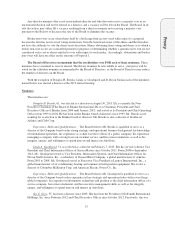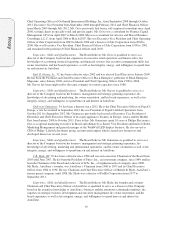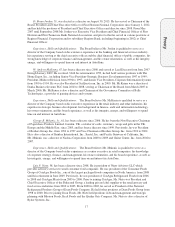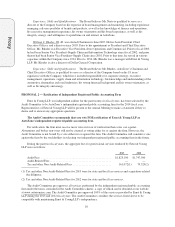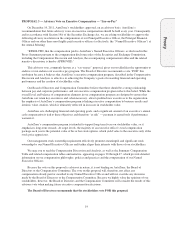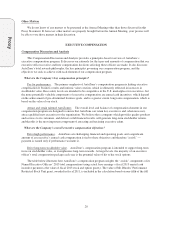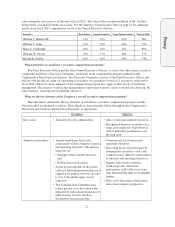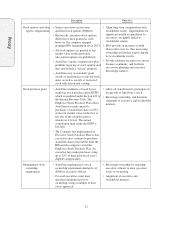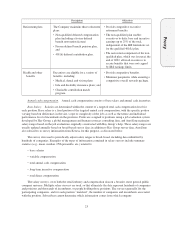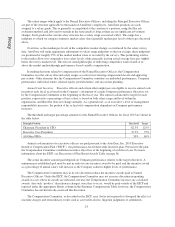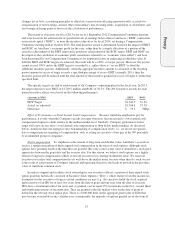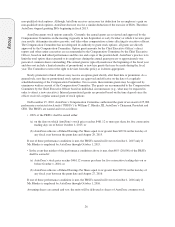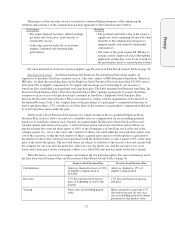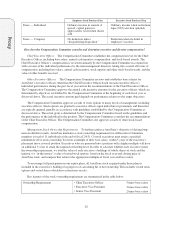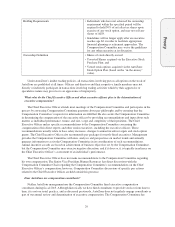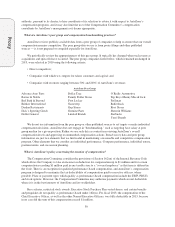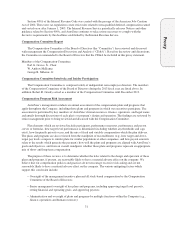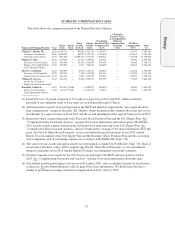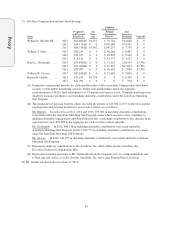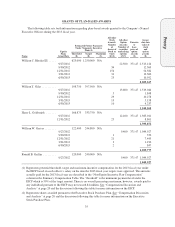AutoZone 2013 Annual Report Download - page 35
Download and view the complete annual report
Please find page 35 of the 2013 AutoZone annual report below. You can navigate through the pages in the report by either clicking on the pages listed below, or by using the keyword search tool below to find specific information within the annual report.
Proxy
changes in tax laws, accounting principles or other laws or provisions affecting reported results, accruals for
reorganization or restructuring, and any other extraordinary non-recurring items, acquisitions or divestitures and
any foreign exchange gains or losses on the calculation of performance.
The incentive objectives for fiscal 2013 were set in a September 2012 Compensation Committee meeting,
and were based on the achievement of specified levels of earnings before interest and taxes (“EBIT”) and return
on invested capital (“ROIC”), as were the incentive objectives for fiscal 2014, set during a Compensation
Committee meeting held in October 2013. The total incentive award is determined based on the impact of EBIT
and ROIC on AutoZone’s economic profit for the year, rather than by a simple allocation of a portion of the
award to achievement of the EBIT target and a portion to achievement of the ROIC target. EBIT and ROIC are
key inputs to the calculation of economic profit (sometimes referred to as “economic value added”), and have
been determined by our Compensation Committee to be important factors in enhancing stockholder value. If
both the EBIT and ROIC targets are achieved, the result will be a 100%, or target, payout. However, the payout
cannot exceed 100% unless the EBIT target is exceeded (i.e., unless there is “excess EBIT” to fund the
additional incentive payout). Additionally, when the aggregate incentive amount is calculated, if the resulting
payout amount in excess of target exceeds a specified percentage of excess EBIT (currently 20%), then the
incentive payout will be reduced until the total amount of the incentive payment in excess of target is within that
specified limit.
The specific targets are tied to achievement of the Company’s operating plan for the fiscal year. In 2013,
the target objectives were EBIT of $1,749.5 million and ROIC of 32.3%. The 2013 incentive awards for each
named executive officer were based on the following performance:
(Amounts in MMs) EBIT ROIC
EICP Target ....................................................... $1,749.5 32.3%
Actual (as adjusted) ................................................. $1,768.6 33.3%
Difference ........................................................ $ 19.1 96Bps
Effect of Performance on Total Annual Cash Compensation. Because AutoZone emphasizes pay for
performance, it is only when the Company exceeds its target objectives that an executive’s total annual cash
compensation begins to climb relative to the median market level. Similarly, Company performance below
target will cause an executive’s total annual cash compensation to drop below market median. As discussed
below, AutoZone does not engage in strict benchmarking of compensation levels, i.e., we do not use specific
data to support precise targeting of compensation, such as setting an executive’s base pay at the 50th percentile
of an identified group of companies.
Stock compensation. To emphasize achievement of long-term stockholder value, AutoZone’s executives
receive a significant portion of their targeted total compensation in the form of stock options. Although stock
options have potential worth at the time they are granted, they only confer actual value if AutoZone’s stock price
appreciates between the grant date and the exercise date. For this reason, we believe stock options are a highly
effective long-term compensation vehicle to reward executives for creating stockholder value. We want our
executives to realize total compensation levels well above the market norm, because when they do, such success
is the result of achievement of Company financial and operating objectives that leads to growth in the per-share
value of AutoZone common stock.
In order to support and facilitate stock ownership by our executive officers, a portion of their annual stock
option grant has historically consisted of Incentive Stock Options (“ISOs”), which feature favorable income tax
treatments for the executive as long as certain conditions are met (e.g., the executive holds the stock acquired
upon exercise of an ISO for at least two years from the date of grant and one year from the date of exercise).
ISOs have a maximum term of ten years and, as granted, vest in equal 25% increments on the first, second, third
and fourth anniversaries of the grant date. They are granted at the fair market value on the date of grant as
defined in the relevant stock option plan. There is a $100,000 limit on the aggregate grant value of ISOs that
may become exercisable in any calendar year; consequently, the majority of options granted are in the form of
25


